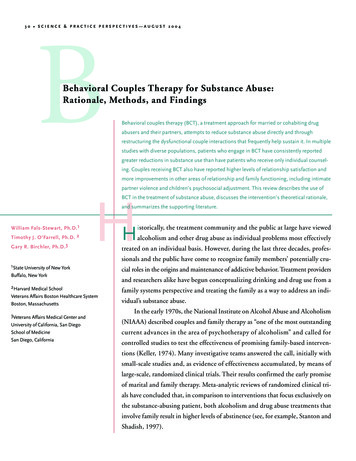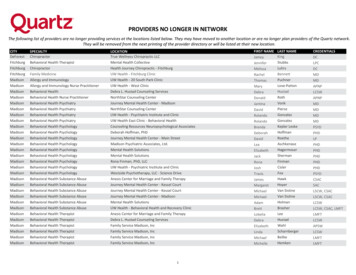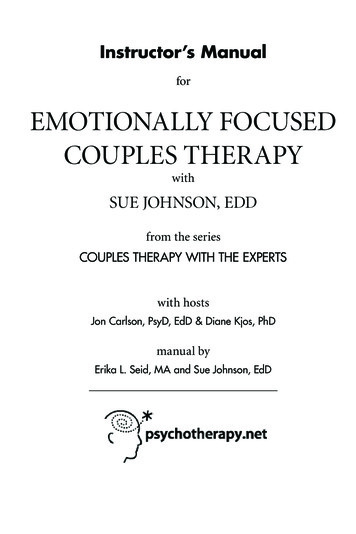
Transcription
30 SCIENCE & PRACTICE PERSPECTIVES—AUGUST 2004BBehavioral Couples Therapy for Substance Abuse:Rationale, Methods, and FindingsBehavioral couples therapy (BCT), a treatment approach for married or cohabiting drugabusers and their partners, attempts to reduce substance abuse directly and throughrestructuring the dysfunctional couple interactions that frequently help sustain it. In multiplestudies with diverse populations, patients who engage in BCT have consistently reportedgreater reductions in substance use than have patients who receive only individual counseling. Couples receiving BCT also have reported higher levels of relationship satisfaction andmore improvements in other areas of relationship and family functioning, including intimatepartner violence and children’s psychosocial adjustment. This review describes the use ofBCT in the treatment of substance abuse, discusses the intervention’s theoretical rationale,Hand summarizes the supporting literature.William Fals-Stewart, Ph.D. 1Timothy J. O’Farrell, Ph.D. 2Gary R. Birchler, Ph.D. 3Historically, the treatment community and the public at large have viewedalcoholism and other drug abuse as individual problems most effectivelytreated on an individual basis. However, during the last three decades, professionals and the public have come to recognize family members’ potentially cru-1State University of New Yorkcial roles in the origins and maintenance of addictive behavior. Treatment providersBuffalo, New Yorkand researchers alike have begun conceptualizing drinking and drug use from a2Harvard Medical Schoolfamily systems perspective and treating the family as a way to address an indi-Veterans Affairs Boston Healthcare SystemBoston, Massachusetts3Veterans Affairs Medical Center andvidual’s substance abuse.In the early 1970s, the National Institute on Alcohol Abuse and AlcoholismUniversity of California, San Diego(NIAAA) described couples and family therapy as “one of the most outstandingSchool of Medicinecurrent advances in the area of psychotherapy of alcoholism” and called forSan Diego, Californiacontrolled studies to test the effectiveness of promising family-based interventions (Keller, 1974). Many investigative teams answered the call, initially withsmall-scale studies and, as evidence of effectiveness accumulated, by means oflarge-scale, randomized clinical trials. Their results confirmed the early promiseof marital and family therapy. Meta-analytic reviews of randomized clinical trials have concluded that, in comparison to interventions that focus exclusively onthe substance-abusing patient, both alcoholism and drug abuse treatments thatinvolve family result in higher levels of abstinence (see, for example, Stanton andShadish, 1997).
RESEARCH REVIEW—BEHAVIORAL COUPLES THERAPY 31Three theoretical perspectives have come to dominate family-based conceptualizations of substanceabuse and thus provide the foundation for the treatment strategies most often used with substance abusers.(For a review of these approaches, see Fals-Stewart,O’Farrell, and Birchler, 2003a.) The family disease approach, the best known model,views alcoholism and other drug abuse as illnessesof the family, suffered not only by the substanceabuser, but also by family members, who are seenas codependent. Treatment consists of encouragingthe substance-abusing patient and family membersto address their respective disease processesindividually; formal family treatment is not theemphasis. The family systems approach, the second widely usedmodel, applies the principles of general systems theory to families, paying particular attention to theways in which family interactions become organizedaround alcohol or drug use and maintain a dynamicbalance between substance use and family functioning. Family therapy based on this model seeksto understand the role of substance use in the functioning of the family system, with the goal of modifying family dynamics and interactions to eliminate the family’s need for the substance-abusingpatient to drink or use drugs. A third set of models, a cluster of behavioral approaches,assumes that family interactions reinforce alcoholand drug-using behavior. Therapy attempts to breakthis deleterious reinforcement and instead fosterbehaviors conducive to abstinence.Derived from this general behavioral conceptualization of substance abuse, behavioral couples therapy (BCT) is the approach to couples and family therapy that has, by our analysis, the strongest empiricalsupport for its effectiveness (O’Farrell and Fals-Stewart,2003). It is demonstrating success in broadly diversepopulations, from very poor to wealthy, and amonga broad range of ethnic and racial groups. This reviewprovides brief discussions of the theoretical rationalefor the use of BCT with substance-abusing patients,including: BCT methods typically used with substanceabusing patients and their partners; Research findings supporting the effectiveness ofBCT in terms of its primary outcome goals (reduction or elimination of substance use and improvement in couples’ adjustment); and Recently completed investigations that have shownpositive effects of BCT on domains of functioningnot specifically targeted by the intervention, suchas reduced intimate partner violence and improvedemotional and behavioral functioning on the partof children in the family.THEORETICAL RATIONALEThe causal connections between substance use andrelationship discord are complex and reciprocal.Couples in which one partner abuses drugs or alcohol usually also have extensive relationship problems,often with high levels of relationship dissatisfaction,instability (for example, situations where one or bothpartners are taking significant steps toward separation or divorce), and verbal and physical aggression(Fals-Stewart, Birchler, and O’Farrell, 1999). Relationship dysfunction in turn is associated with increasedproblematic substance use and posttreatment relapseamong alcoholics and drug abusers (Maisto et al.,1988). Thus, as shown in the “destructive cycle” segment of the figure, “Reversing a Destructive CycleThrough Behavioral Couples Therapy,” substanceuse and marital problems generate a destructive cyclein which each induces the other.In the perpetuation of this cycle, marital andfamily problems (for example, poor communicationand problemsolving, habitual arguing, and financialstressors) often set the stage for excessive drinking ordrug use. There are many ways in which family responsesto the substance abuse may then inadvertently promote subsequent abuse. In many instances, for example, substance abuse serves relationship needs (at leastin the short term), as when it facilitates the expression of emotion and affection through caretakingof a partner suffering from a hangover.Recognizing these interrelationships, BCT andfamily-based treatments for substance abuse in general have three primary objectives: To eliminate abusive drinking and drug abuse; To engage the family’s support for the patient’sefforts to change; and To restructure couple and family interaction patternsin ways conducive to long-term, stable abstinence.As depicted in the “constructive cycle” segmentof the figure, BCT attempts to create a constructivecycle between substance use recovery and improvedrelationship functioning through interventionsthat address both sets of issues concurrently.
32 SCIENCE & PRACTICE PERSPECTIVES—AUGUST 2004Reversing a Destructive Cycle Through Behavioral CouplesTherapyReversing a Destructive Cycle Through BehavioralCouples TherapyArguments About Past UseNagging BehaviorCaretakingSubstance UseRelationship DysfunctionLack of Caring BehaviorsPoor Communication andProblemsolvingThe Constructive Cycle of Substance AbuseRecovery and Enhanced RelationshipsCommunicationSkills TrainingRelationshipEnhancementIncrease in CaringBehaviorsProblemsolvingSkillsSubstance Use RecoveryEnhanced Relationship FunctionContinuingRecovery PlanStandard SubstanceAbuse TreatmentSelf-HelpSupportRecoveryContractBCT METHODSBCT is mosteffective whenonly one partner has a problem with drugsor alcohol.BCT can be conducted in several formats and delivered either as a standalone intervention or as an adjunctto individual substance abuse counseling. In standardBCT, the therapist sees the substance-abusing patientand his or her partner together, typically for 15 to20 outpatient couple sessions over 5 to 6 months.However, under some circumstances, therapists mayadminister group behavioral couples therapy (GBCT),treating three or four couples together, usually over9 to12 weeks. If necessary, a course of brief behavioralcouples therapy can be accomplished in six sessions.Appropriate Candidates for BCTBecause BCT relies on harnessing the influence of thecouples system to promote abstinence, it is suitableonly for couples who are committed to their relationships. We generally require that partners be marriedor, if unmarried, cohabiting in a stable relationship forat least 1 year; if separated, attempting to reconcile.In addition, BCT, like other behavioral treatments, isskill-based and relies heavily on participants’ abilities to receive and integrate new information, complete assignments, and practice new skills. Thus, bothpartners must be free of conditions such as grosscognitive impairment or psychosis that would interfere with the accomplishment of these tasks.The BCT model assumes that both partners haveabstinence from drugs or alcohol as their primary goal.BCT is therefore most effective when only one partner has a problem with drugs or alcohol. Relationshipsin which both partners abuse drugs often do not support abstinence and may be antagonistic to cessationof drug abuse. Compared to couples in which onlyone partner abuses drugs, “dually addicted” couplesoften report more relationship satisfaction, particularly when the partners use drugs together (Fals-Stewart,Birchler, and O’Farrell, 1999). They apparently haveless conflict related to substance abuse, and attempting to reduce their substance abuse may reducetheir relationship satisfaction by depriving them of aprimary shared rewarding activity. Attempting toaddress the substance abuse of only one partner in adually addicted couple—the most common circumstance, since both partners rarely seek help at the sametime—often creates conflict that may be resolved onlythrough either dissolution of the relationship or continued drug use by the partner being treated.Couples are also excluded from participation inBCT if there is evidence that the relationship is significantly destructive or harmful to one or both partners. In particular, BCT is contraindicated for couples with histories of severe physical aggression. Forexample, couples are not appropriate candidates ifthey report violence within the last year that necessitated medical attention or if either partner describesbeing physically afraid of the other. Such partners arereferred for domestic violence treatment, and thesubstance-abusing partner receives counseling for hisor her drinking or drug abuse.Exclusion rates vary according to gender. Theman is much more frequently the sole substance abuser
RESEARCH REVIEW—BEHAVIORAL COUPLES THERAPY 33in a couple, and consequently women are much morefrequently excluded on the basis of being in a duallyaddicted pair. In fact, as many as 50 percent of womenentering treatment may be excluded from standardBCT on these grounds. Alternative programs for thesewomen are under development.Among individuals entering outpatient treatmentwho are offered BCT, roughly 80 percent choose toparticipate.Sample Calendar for Recording RecoveryContract ActivitiesGeneral Session Content and ProceduresThe BCT approach has been fully manualized, withmanuals and related materials readily available toresearchers and practitioners.1 During initial BCTsessions, therapists work to decrease the couple’s negative feelings and interactions about past and possible future drinking or drug use, and to encourage positive behavioral exchanges between the partners. Latersessions move to engage the partners in communication skills training, problemsolving strategies, andnegotiation of behavior change agreements.At the outset of BCT, the therapist and the couple together develop a recovery contract. As part ofthe contract, the partners agree to engage in a dailyabstinence trust discussion (or sobriety trust discussion). In this brief exchange, the substance-abusingpartner typically says something like, “I have not useddrugs in the last 24 hours and I intend to remain abstinent for the next 24 hours.” In turn, the nonsubstance-abusing partner expresses support byresponding, for example, “Thank you for not drinking or using drugs during the last day. I want toprovide you the support you need to meet your goalof remaining abstinent today.”For patients taking medications such as naltrexone or disulfiram to facilitate abstinence, ingestion of each day’s dose can be a component of theabstinence trust discussion, with the non-substanceabusing partner witnessing and providing verbal reinforcement. The non-substance-abusing partner recordsthe performance of the abstinence trust discussionand other activities in the recovery contract (for example, attendance at self-help support groups) on a calendar provided by the therapist. The calendar is anongoing record of progress that the therapist can praisein BCT sessions, as well as a visual and temporal recordof problems with adherence. (See “Sample Calendarfor Recording Recovery Contract Activities.”) Duringeach BCT session, the partners perform behaviorsM consumption of abstinence-supporting medicationA attendance at Alcoholics Anonymous meetingü completion of abstinence trust discussionstipulated in their recovery contract, such as theirabstinence trust interaction, which highlights thebehaviors’ importance and enables the therapist toobserve and provide affirming or corrective feedback.BCT sessions tend to be moderately to highlystructured, with the therapist setting a specific agendaat the start of each meeting. Typically, the therapistbegins by asking about urges to break abstinence sincethe last session and whether any drinking or drug usehas occurred. The therapist and the partners reviewcompliance with agreed-upon activities since the lastsession and discuss any difficulties the couple mayhave experienced.The session then moves to a detailed review ofhomework and the partners’ successes and problemsin completing their assignments. The partners reportany relationship or other problems that may havearisen during the last week, with the goal of resolvingthem or designing a plan to resolve them. The therapist then introduces new material, such as instructionin and rehearsal of skills to be practiced at home during the ensuing week. Toward the end of thesession, partners receive new homework assignmentsto complete before the next session.BCT also employs a set of behavioral assignments designed to increase positive feelings, sharedThe BCTapproach hasbeen fullymanualized,with manualsand relatedmaterials readily available toresearchersand practitioners.
34 SCIENCE & PRACTICE PERSPECTIVES—AUGUST 2004When Progress in Behavioral Couples Therapy Is Insufficient: How the Therapist RespondsProblemCriterionTherapist’s ResponseRelationship distressEither partner, 3 weeks in a row, reports clinically significant relationship distress.Focus on relationship enhancement andcommunications skills training.Continued or renewed substance useThe substance-abusing partner reports substance use 2 weeks in a row or urges to use3 weeks in a row.Place greater emphasis on substanceuse issues. Encourage attendance atself-help meetings and more frequentcontact with the individual counselor.Identify and reduce the stressors underlying or contributing to cravings.Noncompliance with homeworkThe couple fails to complete homework2 weeks in a row.Isolate and eliminate factors interferingwith completion. Reduce the amount ofhomework to a level manageable byboth partners.Arguments about past substanceabuseEither partner reports such arguments2 weeks in a row. This violates one of themajor tenets of the intervention, whichfocuses on the future, not the past.Encourage the non-substance-abusingpartner to discuss these issues in AlAnon meetings or with an individualcounselor.Angry touchingThere have been episodes of mild physicalaggression between partners.Reiterate the couple’s commitment notto resolve conflict with physical aggression of any kind; emphasize conflict resolution skills.Severe violence (e.g., behavior causinginjury or fear) is another matter. Referpartner to domestic violence treatmentand cease BCT.activities, and constructive communication, all ofwhich are viewed as conducive to abstinence (FalsStewart, O’Farrell, and Birchler, 2003b): In the “Catch Your Partner Doing Something Nice”exercise, each partner notices and acknowledges onepleasing behavior that the significant other performseach day. In the “Caring Day” assignment, each partner plansahead to surprise the other with a day when he orshe does some special things to show caring. Planning and engaging in mutually agreed-uponshared rewarding activities are important; manysubstance abusers’ families have lost the custom ofdoing things together for pleasure, and regaining itis associated with positive recovery outcomes. Practicing communication skills—paraphrasing,empathizing, and validating—can help thesubstance-abusing patient and his or her partnerbetter address stressors in their relationship and theirlives. These skills are also believed to reduce the riskof relapse to substance abuse.As a condition of the recovery contract, both partners agree not to discuss past drinking or drug abuse,or fears of future substance abuse, between scheduledBCT sessions. This agreement reduces the likelihoodof substance-abuse-related conflicts occurring outsidethe therapy sessions, where they are more likely to trigger relapses. Partners are asked to reserve such discussions for the BCT sessions, where the therapist canmonitor and facilitate the interaction.
RESEARCH REVIEW—BEHAVIORAL COUPLES THERAPY 35Throughout BCT, the therapist monitors bothpartners’ relationship satisfaction. In each session, thepartners complete two brief measures: the MaritalHappiness Scale (Azrin, Naster, and Jones, 1973),which assesses relationship adjustment for the previous week, and the Response to Conflict Scale (Birchlerand Fals-Stewart, 1994), which evaluates the partners’ use of maladaptive methods such as yelling, sulking, or hitting to handle relationship conflict during the last week.If the partners are not making sufficient progressin any areas, the therapist gives greater attention toskills that address the specific problems. For example, if the patient is not abusing or reporting urges toabuse drugs or alcohol, but the partners report thattheir relationship conflict and distress are not abating, the therapist stresses relationship enhancementexercises and communication skills (see “WhenProgress in Behavioral Couples Therapy Is Insufficient:How the Therapist Responds”).Coordination With Other Therapy ComponentsIf, as typically happens, BCT is provided in conjunction with individual substance abuse counseling,the respective treatment providers share informationabout the patient’s progress. Such coordination isessential to maximize the effectiveness of both modalities, as patients often disclose problems in one typeof counseling that are best addressed in the other treatment format. For instance, a couple might discuss ina BCT session the patient’s need for vocational training to obtain a higher paying job, but the individualtreatment provider is usually better positioned to coordinate such training as part of the patient’s overalltreatment plan.Planning for Continuing RecoveryOnce the couple has attained stability in abstinenceand relationship adjustment, the partners and thetherapist begin discussing plans for maintaining therapy gains after formal BCT is completed. From a couples therapy perspective, relapses can take the formof a return to substance use or a recurrence of relationship difficulties. Consistent with Marlatt and Gordon’s(1985) seminal work on relapse prevention, thetherapist discusses openly with both partners the factthat relapse is a common, though not inevitable, partof the recovery process. The therapist also emphasizesthat relapse does not indicate that the treatment hasfailed and encourages the couple to make plans tohandle such occurrences.There is a strong tendency for the non-substanceabusing member of the couple to see any relapse tosubstance abuse by his or her partner as a betrayal ofthe relationship, a failure of the treatment, and anindication that their problems are never going to end.To counter this response, the discussion and planningfor relapse include encouragement for both partnersto view relapse, if it should occur, as a learningexperience and not a reason to abandon hope andcommitment.In the final BCT sessions, the couple writes acontinuing recovery plan. The plan provides an overviewof the couple’s ongoing post-BCT activities to promote stable abstinence (for example, a continuingdaily abstinence trust discussion and attendance atself-help support meetings), relapse contingency plans(such as recontacting the therapist, re-engaging inself-help support meetings, contacting a sponsor),and activities to maintain the quality of their relationship (for example, by continuing to scheduleshared rewarding activities).Most partnerswho participate in BCTreport that thehighly structured sessionsand activitybased homework exercisesare a welcomechange fromtheir otherwiseThe Appropriate Therapeutic StanceThe therapist’s ability to develop a strong collaborative therapeutic alliance with the partners is essentialfor successful BCT. Key therapeutic skills includeempathizing, instilling a sense of hope, and working on mutually established goals. The most commonclinical barrier to engaging and allying with couplesin treatment is partners’ fears that sessions will becomea forum for laying blame on each other. To allay suchfears, the therapist should highlight skill-buildinggoals and focus consistently on the present and futurerather than the processing of emotional reactions topast problems. Most partners who participate in BCTreport that the highly structured sessions andactivity-based homework exercises are a welcomechange from their otherwise chaotic lifestyles.Although most couples who participate in BCTcomply with session exercises and between-sessionhomework assignments, some do not. When partnershave difficulty completing assignments as agreed, thetherapist assesses possible barriers and solicits thecouple’s ideas for enhancing compliance. In addition,the therapist can adjust assignments that may betoo ambitious for some partners, for example, byreducing the weekly quota of self-help meetings. Thechaoticlifestyles.
36 SCIENCE & PRACTICE PERSPECTIVES—AUGUST 2004Allowing thepartners totherapist can also conduct brief telephone conferences with the partners between sessions to assess theirprogress on the week’s assignments and encouragecompletion of the homework.However, noncompliance with agreed-uponassignments is never excused or ignored in BCT.A pattern of avoidance and failure to follow throughon commitments is often characteristic of these couples. Allowing the partners to break commitments intherapy is likely to undermine the goals of the intervention by perpetuating and reinforcing behaviorsthat may underlie many of the couples’ problems.RESEARCH FINDINGSbreak commitments in therapy is likely toundermine thegoals of theinterventionby perpetuating and reinforcingbehaviors thatmay underliemany of thecouples’ problems.Investigations over 30 years have compared drinkingand relationship outcomes obtained with BCT to theresults of various non-family-focused interventions, such as individual counseling sessions and grouptherapy. The earlier studies measured outcomes at6 months after treatment, the more recent investigations at 18 to 24 months. Despite variations in methods of assessment, in certain aspects of BCT, and inthe types of individual-based treatments used for comparison, the results have consistently indicated lessfrequent drinking, fewer alcohol-related problems,happier relationships, and lower risk of marital separation with BCT (McCrady et al., 1991).Research on the effects of BCT for patients whoabuse drugs other than alcohol got under way muchlater but has already shown substantial positive results.The first randomized study compared BCT plus individual treatment to equally intensive individual treatment (the same number of therapy sessions duringthe same time period) for married or cohabiting malepatients entering an outpatient substance abuse treatment program (Fals-Stewart, Birchler, and O’Farrell,1996). The individual-based treatment (IBT) methodused in this study was a cognitive-behavioral coping skills intervention designed to teach patients howto recognize relapse triggers, how to deal with urgesto use drugs, and related skills.About 50 percent of the men who received BCTduring the study remained abstinent from alcoholand other drugs, compared to 30 percent of theIBT group. During the year after treatment, fewermembers of the group who received BCT had drugrelated arrests (8 percent v. 28 percent) and inpatienttreatment episodes (13 percent v. 35 percent) thanthe comparison group; and BCT recipients main-tained a larger percentage of abstinent days(67 percent v. 45 percent) than the IBT group. Coupleswho received BCT also reported more positive relationship adjustment and fewer days of separationcaused by discord than couples in which the male partner received only individual treatment. Similar resultsfavoring BCT over individual counseling were observedin another randomized clinical trial that involvedmarried or cohabiting male patients in a methadonemaintenance program (Fals-Stewart, O’Farrell, andBirchler, 2001a).Fals-Stewart and O’Farrell (2003) completed astudy of behavioral family contracting (BFC)-plusnaltrexone therapy for male opioid-dependent patients.The BFC intervention, a variant of BCT that allowsfor the inclusion of family members other than spouses,focuses primarily on establishing and monitoring arecovery contract between the participants, with lessattention to other prominent aspects of standard BCTsuch as communication training and relationshipenhancement exercises. In our BFC study, 124 outpatient men who were living with a family member(66 percent with spouses, 25 percent with parents, and9 percent with siblings) were randomly assigned toone of two equally intensive 24-week treatments: BFC plus individual treatment. Patients had bothindividual and family sessions and took naltrexonedaily in the presence of a family member as partof the recovery contract. Individual-based treatment only. Patients were prescribed naltrexone and were asked in counseling sessions about their compliance, but there was no family involvement or compliance contract.In the course of this study, BFC patients ingestedmore doses of naltrexone than their IBT-only counterparts, attended more scheduled treatment sessions,remained continuously abstinent longer, and had significantly more days abstinent from opiate-based andother illicit drugs during treatment and in the yearafter treatment. BFC patients also had significantlyfewer drug-related, legal, and family problems at1-year followup.Winters and colleagues (2002) conducted the firstBCT study that focused exclusively on female drugabusing patients. Seventy-five married or cohabitingwomen with a primary diagnosis of drug abuse (52 percent cocaine, 28 percent opiate, 8 percent cannabis,and 12 percent other drugs) were randomly assignedto one of two equally intensive outpatient treatments:
BCT plus individual-based treatment (a cognitivebehavioral coping skills program); or IBT alone.During the 1-year posttreatment followup, womenwho received BCT had significantly fewer days of substance use, longer periods of continuous abstinence,and higher levels of relationship satisfaction than didparticipants who received individual treatment.The findings were very similar to those obtained inBCT studies with male substance-abusing patients.In all these studies, the effects of BCT on substance use reduction and relationship enhancementare moderate to large, according to Cohen’s (1988)conventions; however, BCT’s effects tend to declineover time once treatment has ended. This is not unexpected, as decay of effects occurs after most psychosocialtreatments for substance abuse. It does indicate, however, that for BCT as well as those other interventions,more emphasis on methods to enhance the durability of benefits is needed. In a study of couples with analcoholic male partner, we found that additional relapseprevention sessions with the couples after the completion of primary treatment helped them sustaintherapy gains (O’Farrell et al., 1993).Patrick Zachmann, 1978 / Copyright 2002, Magnum Photos.RESEARCH REVIEW—BEHAVIORAL COUPLES THERAPY 37emotional and behavioral adjustment of children living in homes with a substance-abusing parent.Intimate partner violenceDually Addicted CouplesWhen both partners in a relationship use drugs,neither traditional individual therapy nor BCT hasproven effective. Research on the dynamics of theserelationships is needed, as is research on interventionsthat might work. A study now in its early stages isexamining the use of a combination of BCT and contingency management techniques. The contingencymanagement component offers material incentives,such as vouchers that can be exchanged for goods andservices unrelated to substance use, provided the partners produce drug-negative urine samples and attendBCT sessions together. Although preliminary resultsare encouraging, far m
the substance-abusing patient, both alcoholism and dr ug abuse treatments that involve family result in higher levels of abstinence (see, for example, Stanton and Shadish, 1997). Behavioral couples therapy (BCT), a treatment approach for married or cohabiting drug abusers and their partners, attempts to reduce substance abuse directly and through










